If you haven’t yet heard of TAXA Trailers, we’ve got a snapshot for you in today’s post. TAXA Outdoors offers an innovative series of small, lightweight travel trailers that we thought our readers might be interested in seeing.
Not only are all of the models of TAXA travel trailers (called “Habitats”) unique and intriguing, but each Habitat is also offered in an overloading version. Choosing the Overlanding package brings upgrades that include beefed-up suspension components to improve their abilities on rough roads or even off-road!
Are these little easy-to-haul rigs for everyone? Nope. But neither is a Class A motorhome! In the RV world, there’s something for everyone.
These little travel trailers could be just the ticket for outdoor enthusiasts who want a compact unit they can keep in the garage and tow with the family SUV.
Who Makes TAXA Trailers?
TAXA Trailers are small, lightweight innovative travel trailers designed and manufactured by the company TAXA Outdoors in Houston, Texas. TAXA says its mission is to get people to enjoy the outdoors by providing them with what they need to live inside their “mobile habitats” while traveling and finding adventure.
They pride themselves on the unique design, build quality, and sustainability of their products. But it’s also important to TAXA that they’re sufficiently lightweight to be towed with the family car, and compact enough to fit in a typical residential garage.
Currently owned by L Catterton, a very large global consumer-focused private equity growth fund, TAXA was founded in 2014 by a NASA architect named Garrett Finney. Finney had worked on the International Space Station and Lunar habitats and had dreams of bringing people back to the outdoors, reconnecting them with nature.
He sketched a design idea on a napkin in 2009, and that sketch eventually became the Cricket mobile human habitat.
What Makes TAXA Trailers Different?
TAXA trailers are made, at least in part, with sustainable materials. The company seeks to protect the environment that they’re providing mobile habitats for people to go and enjoy.
In addition to the use of sustainable materials, TAXA Outdoors has designed its travel trailers to be:
- lightweight so they use less vehicle power (and less fuel) to tow
- durable (requiring fewer resources over time)
- aerodynamic for traveling efficiently down the highway (and thus use less fuel)
TAXA trailers use powder-coated steel, laser-cut aluminum, and aluminum composite panels (Aluminum alloy ASTM B 209) with a powder-coated Kynar exterior and interior (Kynar is a sustainable, water-based resin).
TAXA mobile habitats also incorporate 7-ply baltic birch wood, Douglas Fir plywood, lightweight milk crates for storage, and recyclable ABS laminate. They also use a fairly high R-value (2lb closed-cell) foam core for insulation.
So, in short, what makes TAXA trailers different is:
- their eye on sustainability
- the lightweight, compact nature of every “habitat” they produce (allowing them to be towed by smaller vehicles and stored in a personal garage)
- and what will hopefully prove over time to be a highly-durable product for efficient use both on and off road.
In our recent post entitled “What is Dispersed Camping?” (as well as our posts on recycling while camping and hiking etiquette), we talk about the importance of leaving no trace when camping and hiking. It’s critical to not only preserve the great outdoors for future generations, but to ensure that misuse doesn’t end up resulting in the closure of desirable remote areas.
We appreciate that TAXA Outdoors appears to share this philosophy, even in the eco-friendly design and manufacturing of their mobile habitats. Speaking of which, let’s take a look at these lightweight, compact little gems!
TAXA Mobile Habitats
TAXA habitats are created in five different models, with five additional models that are offshoots from the original five but offer either overlanding or tailgating features. Let’s take a look at the five main models of TAXA trailers and their five rugged siblings.
Mantis 5.2 and Mantis 5.2 Overland
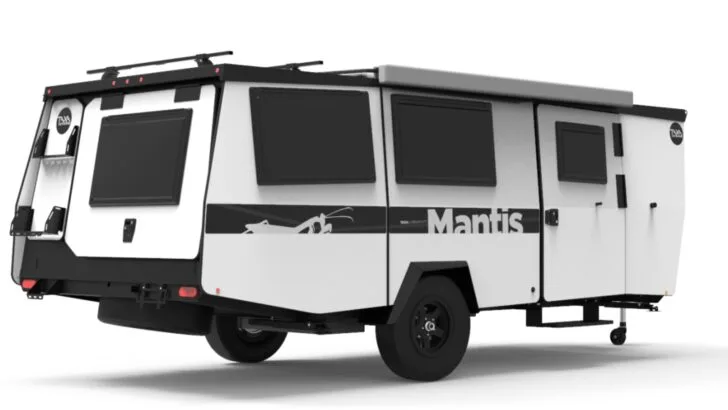
This is TAXA’s Mantis 5.2, the company’s most spacious mobile human habitat! (Source: TAXA Outdoors)
The Mantis 5.2 is TAXA’s most spacious habitat with the ability to sleep 4+ adults and up to 7 people total. At just 19’ long, the 5.2 can be stored in a standard residential garage, and with a dry weight of 3,115 lbs, it’s easily towed. As with other TAXA trailers, Mantis models have a pop-up roof for additional height, space, and ventilation.
The Mantis 5.2 has what TAXA calls an “enhanced shower”. That means it can handle a 6’6″ tall person and includes a long enough hose on the shower wand that it can reach to the door for rinsing off muddy shoes and feet. The 5.2 also has a cool feature of a sitting/standing desk for working in the trailer or for dining, crafting, kids projects, etc.
With a 20-gallon fresh water tank and a 22-gallon gray water tank, the TAXA Mantis 5.2 appears to be well-suited for some short-term boondocking.
For some pretty fascinating additional details on the Mantis 5.2, scroll through the linked page of the TAXA website. You can also check out the features of the rugged Mantis 5.2 Overland!
Meanwhile, check out this floor plan:
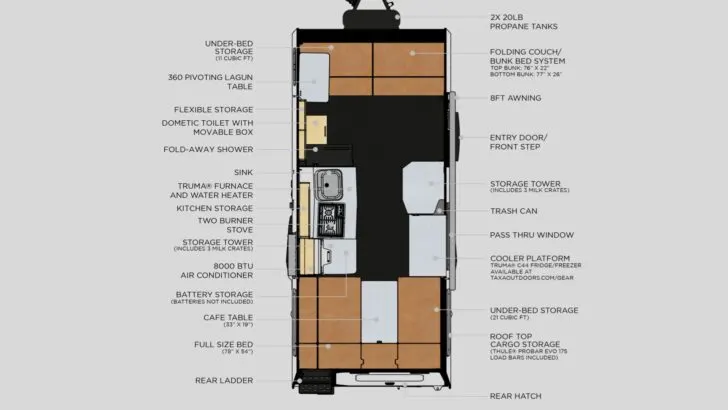
The floor plan for TAXA’s Mantis 5.2 shows some very well thought-out features! (Source: TAXA Outdoors)
Mantis 4.1
The Mantis 4.1 is a 19′-long habitat that can also be stored in a standard 7′ garage. It has a dry weight of only 2,972 lbs.
This habitat has a little more space and will sleep four adults with the queen bed and an optional folding couch bunk bed system. It seats six comfortably when one of the beds is converted to a dinette and the bunk system is dropped to create a couch.
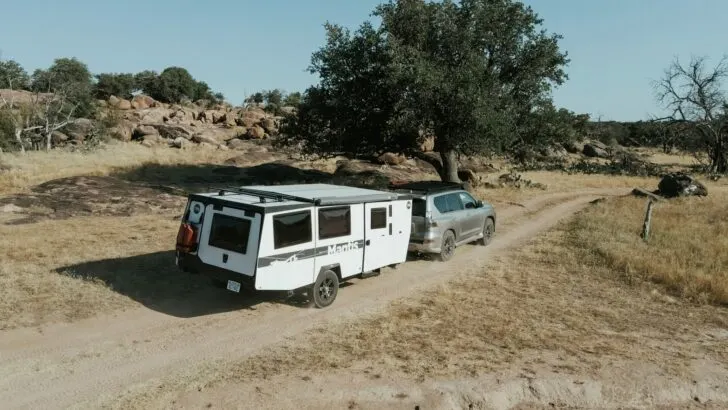
With sleeping quarters for four, and seating for six, the Mantis 4.1 is large enough for many families and can be towed by an SUV. (Photo source: TAXA Outdoors)
The 4.1 has an 8,000 BTU air conditioner that sits on a lockable sliding base that allows the position of the AC unit to be changed to create maximum comfort inside the rig.
This unit has a separate sink, two-burner stove, water heater, a 20-gallon fresh water tank, and a 22-gallon gray water tank. Its interior wet bath includes a cassette toilet, but there’s also an exterior shower with hot and cold water.
Cricket and Cricket Overland
TAXA’s Cricket habitats are just 15′ long and have a dry weight of only 1,800 lbs.
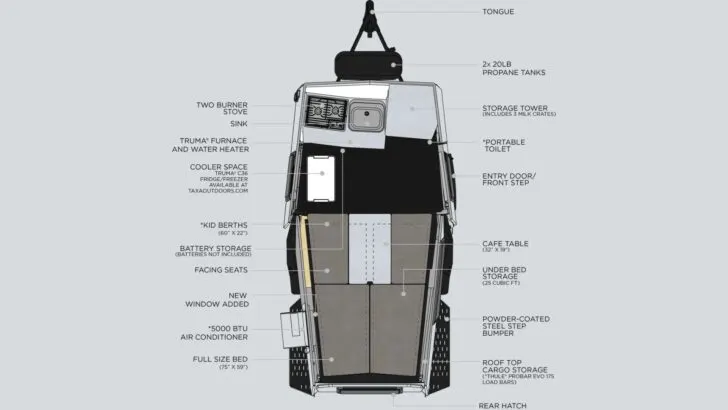
A look at the floorplan of TAXA’s 2021 Cricket shows that TAXA has packed a lot of travel trailer into this little habitat! (Source: TAXA Outdoors)
With sleeping quarters for two adults (and two children with the optional berths), not only are these units suitable for families with a small child or two, they’re also towable by many vehicles with only 4-cylinder engines (i.e. many popular models of SUV).
The Cricket habitats have integrated electrical and plumbing systems with a 15-gallon fresh water tank and a 16-gallon gray water tank. They also include a 5,000 BTU air conditioner installed in a fifth window that TAXA says was created to add a more aerodynamic location for the AC option in Cricket units.
Cricket units offer 63 square feet of living space.
Here’s TAXA Outdoors founder Garret Finney with a video tour of the Cricket!
TigerMoth and TigerMoth Overland
TAXA’s Tiger Moth habitats are tiny, with just 40 sq ft of interior space. At a tiny 12’10” in length, the TigerMoth has a dry weight of only 1,310 lbs.
Like the Crickets, these habitats are towable by many 4-cylinder engined vehicles and have hatches & doors that unfold for ventilation and views.
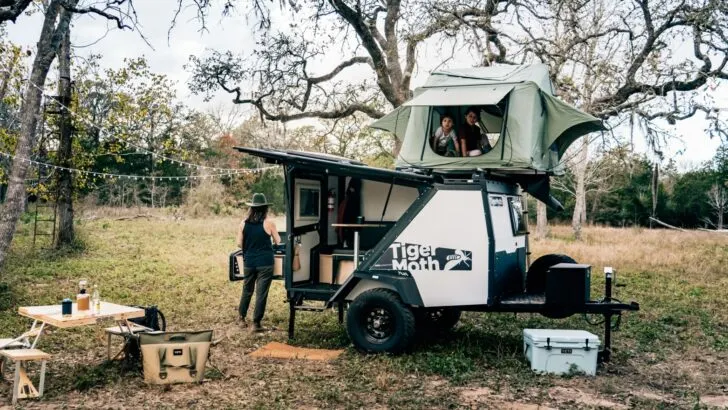
The tiny TigerMoth sleeps two inside (but you’d better really like each other), and an optional rooftop tent provides a sleeping space for a small child or two. (Photo source: TAXA Outdoors)
TAXA Outdoors says you can get 7 or more days off the grid with these little campers. They come with a built-in electrical system, external water system, are pre-wired for solar, and offer enough sleeping space for two adults (expandable to sleeping for 3 if the optional rooftop tent is purchased).
The TigerMoth has a slide-out camp kitchen with a two-burner portable stove. You can read more about the TigerMoth here. Meanwhile, here’s a floorplan to intrigue you.
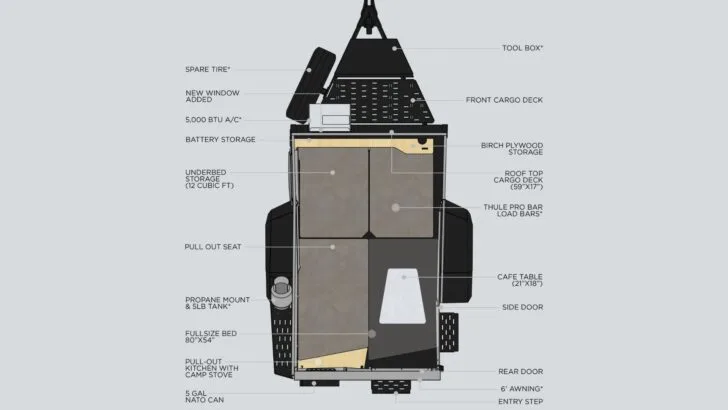
When fully outfitted with all the options, the tiny NASA-inspired TigerMoth fits a whole lotta camping into a tiny space! (Source: TAXA Outdoors)
Woolly Bear, Woolly Bear Overland, and Woolly Bear Tailgate Edition
The Woolly Bear is a tiny basecamp that comes with a full-size outdoor kitchen with stainless steel countertop, a pull-out cooler drawer, and lockable storage compartments on the driver’s and passenger’s sides. It also has an elevated platform suitable for a 2-3 person tent.
With the rooftop tent installed, you can sleep two or three in a Woolly habitat.
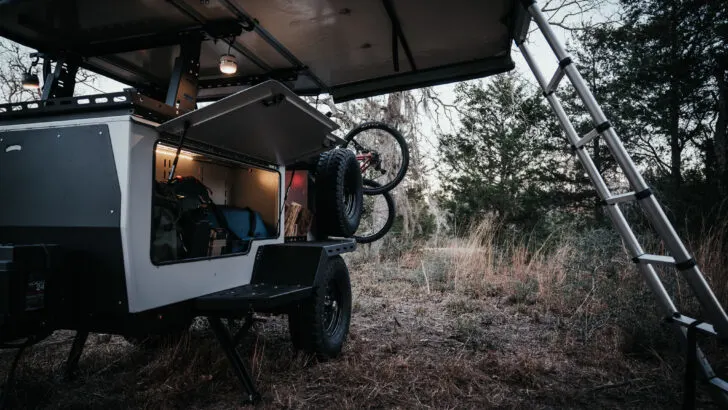
Here’s a Woolly Bear in the wild being fully enjoyed by camping enthusiasts. (Source: TAXA Outdoors)
These little basecamp habitats are only 10’ 8″ long and have a dry weight of only 1,270 lbs. (The Woolly Overland is 11’ 4″ long and has a dry weight of 1,400 lbs.) They have a battery box sized for a group 24 battery, however, a battery isn’t included.
Here’s a peek showing the Woolly Bear both in compact mode and with the tent deployed. You can see much more about the Woolly Bear, Woolly Bear Overlander, and Woolly Bear Tailgate on the TAXA website.
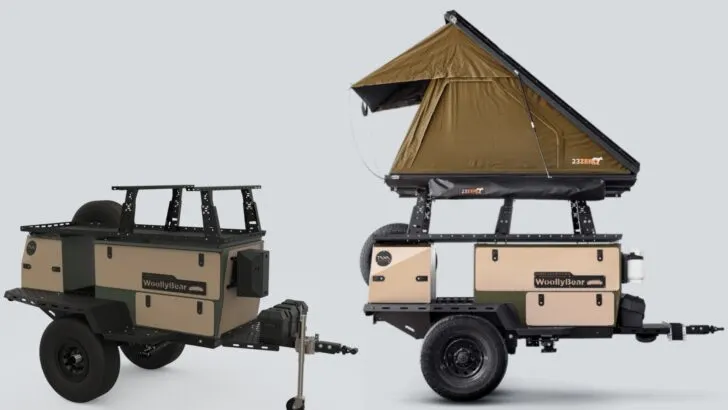
TAXA’s Wooly Bear series consists of three different basecamps including an overland model and a tailgate model. The 2-3 person tent is optional. (Photo source: TAXA Outdoors)
Have You Seen a TAXA Trailer?
If you’ve seen, used, or own a TAXA trailer, we’d love to hear what you think! These are amazingly lightweight and compact units that really seem well-designed for their chosen tasks.
Free RVing Tips, Tricks, Reviews, Giveaways & More
Subscribe to our daily newsletter! We’ve been full-time RVers for 20 years (!) and share everything we’ve learned about RVing in our daily blog posts. Join our online community to receive a wealth of great RVing knowledge delivered right to your inbox.
Whether this is your first time on the road or you’re a seasoned full-timer, you’ll love the wide range of RVing topics we cover. Don’t miss a single article or any of our famous RV gear Giveaways — Subscribe today!

